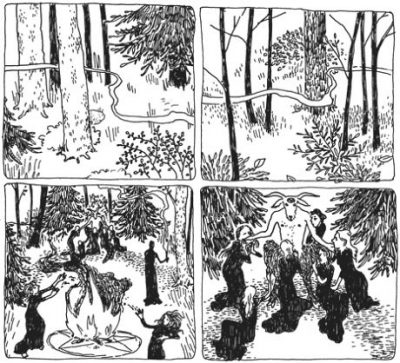Reviewer: Emera
Date read: 6.16.2017
Book from: Gift from K. (<3)
Flesh and Blood is Julia Gfrörer’s first published comic, and my second-favorite of the three I’ve read, after Black is the Color. Grim, wry, blood-and-hemlock-flavored, this is highly recommended for lovers of Robert Eggers’ film The Witch.
This is so narratively satisfying, all the symmetry and the sinewy Machiavellian strength of the witch’s plotting. She’s a dark free agent, pulling snare-cords neat and tight around convenient prey. She’s not quite so dispassionate a predator as the mermaids in Black is the Color, though. Displaced romantic and erotic desire teases the otherwise calm, chilly surface of her calculations. This culminates in an uncomfortably powerful erotic scene involving a mandrake. Period.
The displacement of desire and passion – longing for what’s not close to hand, fulfillment through proxies – creates a weird kind of momentum throughout Flesh and Bone. I imagine water continually spilling from unstable vessel to vessel, never at rest, and shared between vessels only in passing.
Like all of Gfrörer’s work that I’ve read, the comic is also an inhabitation of the experience of grief – grief that is more than sorrow, grief that wrings to the bone. This grief that strains the limits of human capability – and the teasing touches of hopeful sweetness, as expressed through longing and eroticism – all that mixed together, in one brief comic, it’s exquisite, and sublime.
Gfrörer’s work is an uncommonly raw expression of the intensity of existence. It goes deep, deep, deep, like almost nothing I’ve read or seen before, except (as I said before) Ingmar Bergman’s The Seventh Seal. There is nothing precious, or half-way, or untrue about her work. I think she’s a visionary not in the sense of seeing something beyond – I think she looks at human existence and sees in.
Related reading:
Laid Waste, by Julia Gfrörer (2016): review by Emera
If you’ve enjoyed our posts, consider contributing a dollar or two to help support our blog.



